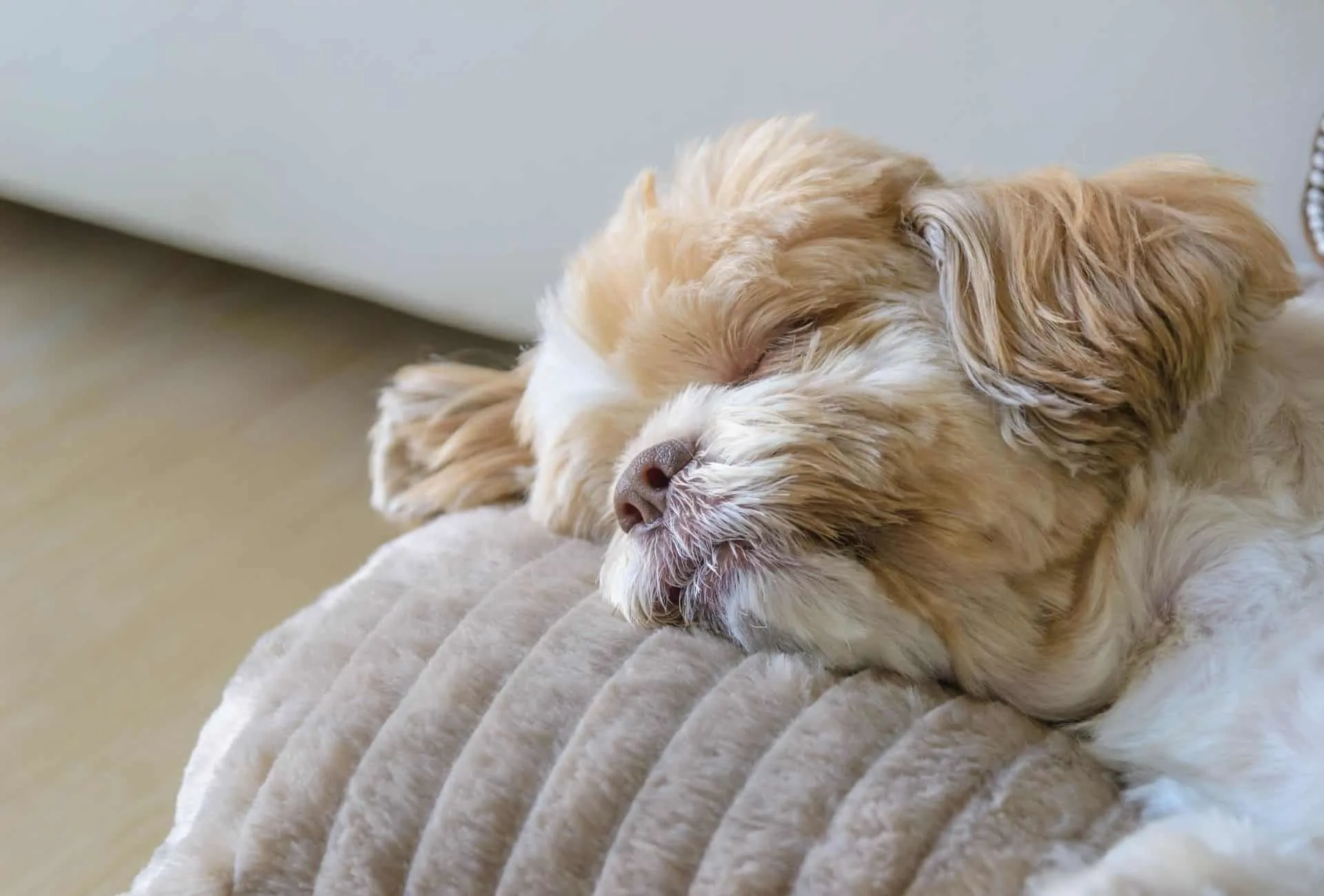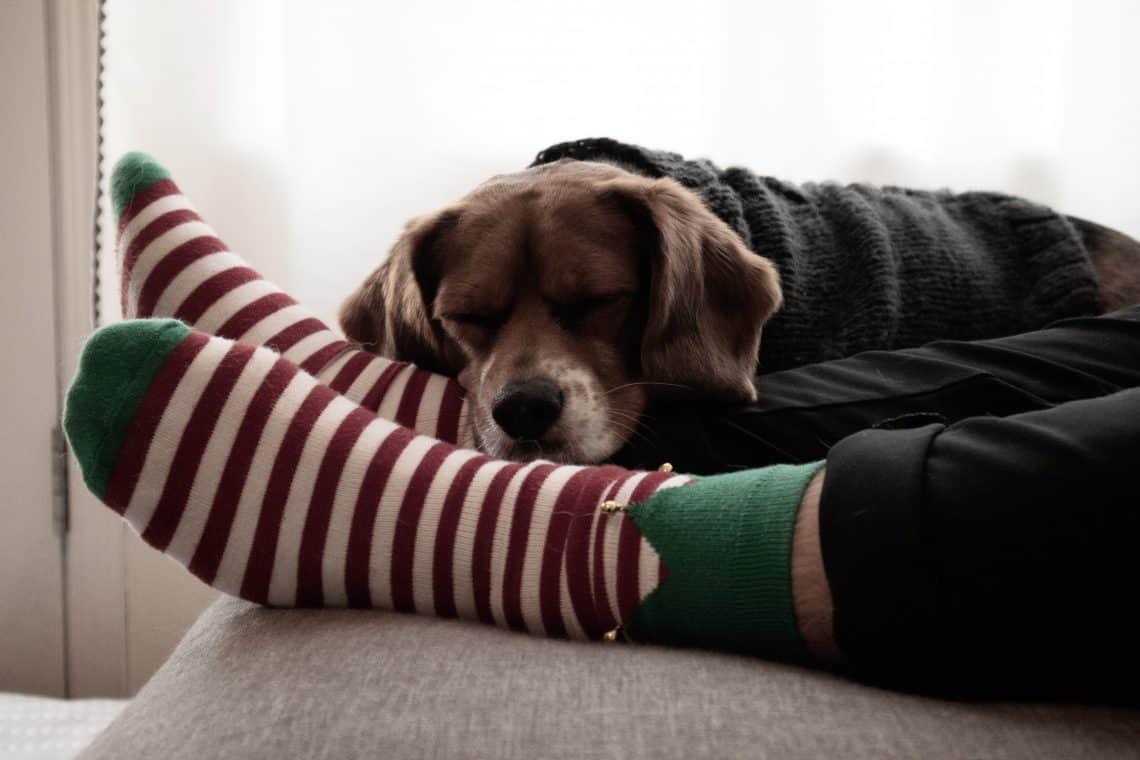Did you know that every second dog owner lets their pets sleep in their beds?
According to the 2021–2022 APPA Survey1, 43 percent of pet dogs in the U.S. sleep on their owner’s bed. A study2 conducted by Canisius College in N.Y. also found that 49% of Australian dog owners let their dogs sleep in their bed.
Both the 2020 Stonyfield Organic survey3 as well as the 2022 Veterinarians.org online survey4 among 1,000 adults in the U.S. found that up to 74-76% let their dogs sleep in their bed.
While it may be soothing for some to have a warm cloud resting in their bed, many others suffer from insomnia.
Especially large breeds can easily roll over your whole body, hog your blanket, or sleep on your pillow.
Although I’d love to, I couldn’t imagine sleeping in bed with my nearly 100lbs Rottweiler girl if she’d attempt to sleep on the pillow.
Luckily, my Rottie prefers the bottom part of the bed and she’s rarely allowed on there anyway.
But why do dogs sleep on your pillow in the first place? Even when you are not at home or during the daytime?
Reasons for your dog sleeping on your pillow can be simply for warmth or imitation but they can also range from your dog protecting you, over to the soothing effect the owner’s scent has, all the way to territorialism or marking.
But that scratches the surface. Let’s dive in.
Why Does My Dog Like My Pillow?
There are many different reasons why your dog likes sleeping on your pillow and even prefers it to his own bed or crate.
Scent
Dogs love the scent of their owners.
Several studies have shown that the pleasure center of the canine’s brain reacts to the owner’s odor more than any other smell.
Your dog will try to stay as close to this scent as possible and will still lay on your pillow during the day or when he is left home alone.

It will help him sleep better and stay calm when he feels anxious and alone.
That’s why it’s a great idea to place a blanket with the mother’s scent in your puppy’s crate during the first few nights.
The familiar smell will help with the separation anxiety and the stress of being in a new home.
Recommended Reading: How to Survive Your Puppy’s First Night at Home
Protection
If you have a dog that tends to be protective, this behavior will occur most during the night.
When you are fast asleep, your dog will climb on your pillow to protect you from whatever danger may enter the home.
Your dog may know that you are the most vulnerable when you are sleeping.
His protective behavior may occur in many day-to-day situations and is not limited to the bedroom.
He will only be sleeping on your pillow when you are doing the same.
If you have a baby, he will most likely choose to sleep in that room because your child is the smallest member of the pack and requires the most protection.
Especially family guardian breeds tend to do this.
Security
The amount of security your dog receives from resting on your pillow is related to your scent.
Even when you are not at home, your dog wants to be close to you – what place could be better than your own bed full of smells?
Recommended Reading: Complete Guide to Dog Separation Anxiety
Territorialism
Territorial dogs may tend to display possessive traits in which the fight for the pillow can get quite intense.
Possessive dogs like to claim certain objects or places as their own and will protect them against anyone and anything.
Your dog thinks he owns the bed and only allows you to sleep on it (or not).
He might also show signs of food or toy aggression.
It’s not unusual for a territorial dog to carry toys and treats to your pillow as a sign of ownership.
Consult a behaviorist if the aggression gets out of control and you are not allowed on your own bed anymore.
Recommended Reading: How to Stop Food Aggression; 5 Types of Puppy Aggression
Bond
The bond that you have with your dog can determine on which side of the bed he will be sleeping.
This could be the reason why your dog likes to lay on your pillow and not on the pillow of your husband/wife or vice versa.
Wolves in the wild like to cuddle close together to strengthen the relationship and to be protected from enemies.
Your dog will try to connect with you during hours of vulnerability to show his love and trust.
Recommended Reading: How to Bond with Your Dog
Warmth and Comfort
Many dogs sleep on your pillow simply for warmth and comfort and you can provide them an outlet to satisfy that desire.
To be honest, this is a very valid reason.
Who wants to sleep in their crate when they have a comfortable king-size bed available?
The warmth of your body will make everything cozy.
Especially your pillow is soft and snuggly and provides the perfect snooze spot.
Marking
Marking is a form of territorialism.
Your dog spreads his scent on whatever he would like to claim as his own.
He displays his dominance over you or other members of the family and might even show aggression toward them.

Imitation
Dogs are watching and analyzing what we do every day.
Whoever trains the dog (and that may extend to the rest of the family) is the most respected member of the household and your dog may try to imitate that person’s behavior.
Do Dogs Need Pillows?
Now that you have heard all the reasons why your dog might be sleeping on your pillow, the question emerges if dogs really need pillows for their comfort and health.
Dogs don’t need to sleep on pillows during the night or day.
We, as humans, may need this kind of neck support to align our spine during sleep.
But dogs are built completely differently compared to us and their narrow shoulder blades provide them with sufficient support when sleeping on the side.
Some dogs might actively seek out cushions or elevated furniture to rest their head on.
In general, your dog will be choosing the most comfortable spot on his own.
Keep in mind that your dog is spending 16-20 hours a day resting or sleeping so you should provide him with a high-quality dog bed that is optimized for his needs.
A high-quality dog bed supports the joints to improve your dog’s overall health.
My dog loves her headrest and wouldn’t trade anything for her favorite snooze place.
Recommended Reading: 10 Indestructible Dog Beds (including orthopedic ones)
Should I Still Let My Dog Sleep in Bed with Me?
If your dog is just seeking comfort and security, it’s your choice whether or not you want to keep your dog in bed with you.
If you suffer from insomnia or just feel that your dog is taking up too much space then you should think about transitioning him to a dog bed or crate.
Behavior problems such as aggression, possessiveness, or marking should be addressed with the help of a dog trainer or behaviorist.
Keep in mind that dogs thrive with clear rules and routines.
Suddenly restricting access to furniture will evoke confusion in your dog and he will have a hard time understanding why he is being punished.
That’s why it’s incredibly important to set some house rules before you get a dog.
Boundaries are important and should be reinforced from day one.
Changing these rules is not easy and will require patience and a gradual training approach to prevent confusion.
How Do I Get My Dog Off the Pillow?
Provide your dog with the most irresistible and comfortable dog bed you can find.
During the day, you can place the dog bed in your living room or any other room that you are spending a lot of time in.
- Introduce the bed to your dog and throw in a few treats to create a positive association.
- You can place your unwashed pillow cover on the bed to make it even more enticing.
- Additionally, you will want to add a new command that will teach your dog to settle in his dog bed. This will definitely come in handy at night.
To teach the command “settle”, grab a few treats and lure your dog into the dog bed. Once he is inside, give him the command to lie down and reward him.
Treat your dog every few seconds to let him know that you like him being calm inside the bed.
Command him out of the bed again and repeat the process including the luring.
After a few tries, you can add the verbal cue “settle”.
Decrease the luring with your hand and only reward once he completely lays down.
Gradually increase the duration of the “settle” and always give a release command when he is allowed to get up again.
Whenever you are seeing your dog calmly resting in bed, capture the behavior by rewarding him and giving a verbal cue.
At night, you will want to put the dog bed as close as possible to your bed.
Every night, you can increase the distance until he is sleeping at your desired spot (as near as possible to you).
Whenever your dog wants to get onto the bed, command him into his dog bed by using the cue “settle”.
Stay really consistent with the training and always be clear in your instructions.
Be patient with your dog and offer understanding and compassion.
Soon enough your dog will be sleeping completely on his own!
Recommended Reading: Why Is My Dog Twitching in his Sleep?
Sources
- APPA Pet Survey via everydayhealth, 2022: Should You Really Allow Your Pet in Your Bed? ↩︎
- Canisius University study, 2020: Majority of Dogs Have Bed Privileges – Canisius Study ↩︎
- Stonyfield Organic and Lab42: Survey ↩︎
- Veterinarians.org online survey: Should Dogs Sleep On Your Bed? ↩︎
